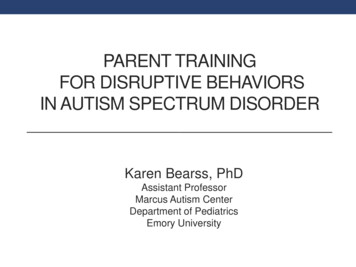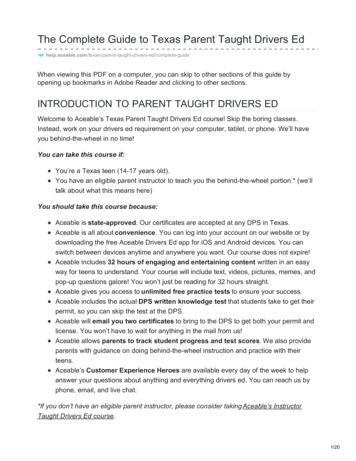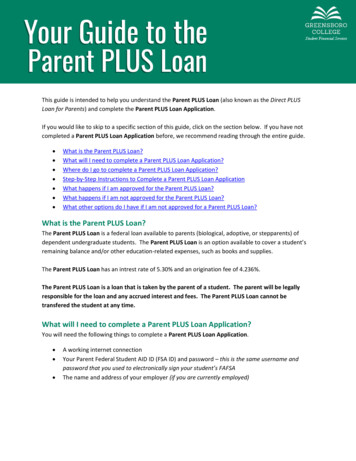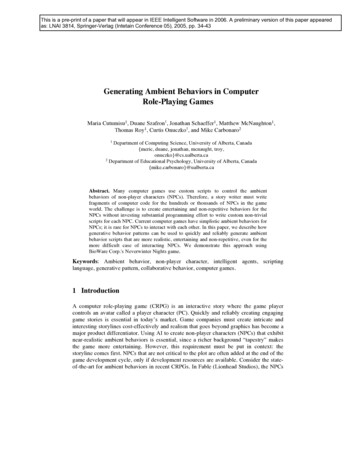
Transcription
PARENT TRAININGFOR DISRUPTIVE BEHAVIORSIN AUTISM SPECTRUM DISORDERKaren Bearss, PhDAssistant ProfessorMarcus Autism CenterDepartment of PediatricsEmory University
Presentation Objectives Review various forms of parent training forautism spectrum disorder Provide an overview of the RUBI Parent Training program Program content Clinical implementation Therapist training procedures Present research findings on the RUBI PT program 2 feasibility, 2 efficacy trials
Autism Spectrum Disorder (DSM 5)A: Deficits in social communication and socialinteraction (blends social with communication)B: Restricted, repetitive patterns of behavior (includesinsistence on sameness)C: Symptoms are present in early childhoodD: Symptoms impair everyday functioningAmerican Psychiatric Association , 2013
ASD: Other Features 4:1 male to female 30 - 40% Intellectually Disabled Impaired daily living skills (not explained by ID) Up to 25% have seizures High rates of serious behavioral problems,hyperactivity and anxiety
Autism Spectrum Disorder Current Prevalence Rates 1 in 68 children (CDC, 2014) 6 per 1,000 children worldwide (Elsabbagh et al, 2012) Broadening case definition Increased public awareness Better tools for measurement
Good News, Bad News Better at identifying children with ASD Few evidence-based treatments Parents overwhelmed by ‘treatment’ choices Google search Autism Treatment 69.6 million hits (up from 37 million last year, 9 million two years ago!!) 6.7 million when you add ‘evidence based’
Added Challenges of Treatment Most EBTs are costly, time- and personnel-intensive Challenge to wide-ranging dissemination Hard for families to access There is a pressing need for trials that will expand theavailability of empirically supported, time-limited,cost-effective treatments for ASD
Parent Training Traditionally a time-limited approach Few hours per week Emphasizes role of parents as the agent of change History as established EBT in child mental health
Why Target Families? Parents of children with ASD report high levels ofstress Higher than parents of children with other chronicmedical or developmental conditions Associated with both core symptomatology anddisruptive behaviorDavis & Carter (2008, JADD), Hastings et al. (2005, JADD)
Why Target Families? Parent inclusion in treatment is not common Difficulties with skill generalization “no problems at school” High rate of accommodation “Walking on eggshells” E.g., dressing child, mashing food
Why Target Families? High Rate of disruptive behavior problems ( 50%) Aggression, noncompliance, SIB, property destruction Communication deficits disruptive behavior Requires skillful responses from parents Adaptive Skills Deficits DLS performance 1 SD below IQ Resistance in learning new skills or performing acquiredskills Noncompliance negatively impacts DLS growth E.g. Getting dressed in the morning
Parents need specific instruction ontechniques to:Improve core symptomsReduce challenging behaviors, andImprove adaptive functioning in their children
Side Bar Karen’s PSA Parent Training Good What exactly is “Parent Training” in ASD
Parent Training (PT) Well established in typically developing children 30 years of rigorous evaluation Focus on externalizing behavior disorders Several models with empirical support Kazdin Method of Parenting Eyberg’s Parent-Child Interaction Therapy Barkley’s Defiant Children Webster-Stratton’s Incredible Years
Parent Training in ASD:Notes on a Literature Search Labels include: “parenttraining” (Coolican, Smith, & Bryson, 2010; Ingersoll & Dvortcsak, 2006; Matson, Mahan,& Matson, 2009; Solomon, Necheles, Ferch, & Bruckman, 2007), “parenteducation” (Koegel, Simon, & Koegel, 2002; Shultz, Schmidt & Stichter, 2012;Stahmer & Gist, 2001; Symon, 2001; Tonge, Brereton, Kiomall, Mackinnon, et al., 2014) “parent-implemented”(McConachie & Diggle, 2007; Nunes & Hanlin, 2007; Reagon &Higbee, 2009; Tarbox, Schiff, & Najdowski, 2010) “parent-mediated”(Diggle, McConachie, & Randle, 2002; Ingersoll & Wainer, 2013; Oono,Honey, & McConahie, 2013; Schertz & Odom, 2007; Siller, Hutman, & Sigman, 2013) “caregiver-mediated”(Kasari et al., 2014)
Parent Training in Autism SpectrumDisorderBearss, Burrell, Stewart & Scahill, 2015Parent SupportKnowledge-focusedChild is Indirect ediated InterventionTechnique-focusedChild is Direct beneficiaryCore iveBehaviorsPrimary(RUBIPT)Complementary(Feeding DayTreatment)Variations in format, location, intensity, duration, target age range
Research on PT in ASD: Core Symptoms 2013 Cochrane Review(Parent Mediated EI in Young Children) 13 of 19 RCT target core symptoms only one study (Green, 2010) adequately powered no study identified a significant reduction inmaladaptive behavior in favor of the parent trainingintervention Within the last 2 years (NDBIs) JASPER ESI ESDM PRT
Research on PT in ASD:Disruptive Behaviors Single case design and small RCTs (proof of concept) Small sample sizes Nonrandom treatment assignment Poorly characterized samples Lack of manualized procedures Idiosyncratic hinders replication
Need for PT EBTs in ASD NIMH Ad Hoc Committee(Smith et al, 2007; Lord et al., 2005; NIMH, 2004)Recognized limitations of current researchOutlined steps to move the field forward Develop a manualized intervention Collect feasibility data Can therapists reliably deliver the treatment? Do parents show up? Do they stay in treatment? Can they do it? Do they like it? Implement large-scale, multi-site, randomized clinical trials Disseminate treatments
Parent Training:Development & Essential Ingredients
RUPP Consortium Risperidone only vs. Risperidone Parent Training Yale Lawrence Scahill, MSN, PhD Indiana Christopher McDougle, MD Ohio State Michael Aman, PhD
Behavioral InterventionsBehav. Intervent. 22: 201–221 (2007)Published online 11 April 2007 in Wiley InterScience(www.interscience.wiley.com) DOI : 10.1002/bin.237Early StepsTextDEVELOPMENT OF A PARENT TRAINING PROGRAMFOR CHILDREN WITH PERVASIVEDEVELOPMENTAL DISORDERSyCynt hia R. Johnson1* , Benjam in L. Handen1, Eric But ter 2, Ann Wagner 3,Jam es M ulick 2, Denis G. Sukhodolsky 4, Susan William s 4, Naom i A. Sw iezy 5,L. Eugene Arnold 2, M ichael G. Am an 2, Law rence Scahill 4, Kim berly A. Stigler 5,Christopher J. M cDougle 5, Benedetto Vitiello 3 and Tristram Sm ith61University of Pittsburgh School of M edicine, USA2Ohio State University, USA3National Institute of M ental Health, USA4Yale University, USA5Indiana University School of M edicine, USA6University of Rochester M edical Center, USA
RUPP Consortium:Manual DevelopmentJohnson et al., 2007 No ‘off the shelf’ parent training manual available Pittsburgh Consultants Cynthia Johnson, PhD and Ben Handen, PhD
Rationale for Behavioral PT Model in ASD Empirical support of Applied Behavior Analysis (ABA)in ASD literature But there is little guidance on when, why and how to useABA techniques in practice (Kasari & Smith, 2013, Autism; Romanczyk etal., 2014, RJADD) And these techniques have not been evaluated in largetrials (Smith et al., 2007, JADD)
PT Intervention Targets Manualize a program that: Reduces challenging behaviors Noncompliance, tantrums, aggression,transitions/daily routines Increases adaptive skills Focuses on antecedent (prevention) andconsequence based strategies, generalization andmaintenance
Parent Training Sessions11 core sessions7 optional sessions Behavioral Principles (the ABC’s) Toileting Prevention Strategies Feeding Daily Schedules Sleep Reinforcement 1 & 2 Time Out Planned Ignoring Imitation Compliance Training Crisis Management Functional Communication Skills Contingency Contracting Teaching Skills 1 & 2 Generalization & MaintenancePLUS 2 Home Visits 2 Telephone Boosters
SESSIONSSKILLS/ACTIVITIESBasic BehavioralPrinciples-Introduce overall treatment goalsIntroduce concepts of functions of behavior, antecedents and consequences of behaviorPrevention Strategies-Discuss antecedents to behavior problems and develop preventive strategies-Develop a daily schedule and identify points of intervention (including use of visualschedules) to decrease behavior problems-Introduce concept of reinforcers – to promote compliance, strengthen desired behaviorsand teach new behaviorsReinforcement 2-Introduce “catching your child being good.”Teach play and social skills through child-led playPlanned Ignoring-Explore systematic use of extinction (via planned ignoring) to reduce behavioral problems-Introduce effective parental requests and the use of guided compliance to enhancecompliance and manage noncompliant behaviors-Through systematic reinforcement, teach alternative communicative skills to replaceproblematic behaviors-Using task analysis and chaining, provide tools to replace problem behaviors withappropriate behaviors and how to promote new adaptive, coping and leisure skillsTeaching Skills 2-Teach various prompting procedures to use while teaching skillsGeneralization &Maintenance-Generate strategies to consolidate positive behavior changes and generalize newly learnedskillsOptional Sessions-Provide instructions on optional topics or review materialsTelephone Boosters-Review implementation of intervention strategiesDevelop interventions for any newly emerging behavior concernsDaily SchedulesReinforcement 1Compliance TrainingFunctionalCommunication TrainingTeaching Skills 1
Program Structure Week 1-16 11 Core Sessions 1 Home Visit Up to 2 Optional Sessions toileting, feeding, sleep, time out Week 17-24 1 Home Visit 2 Booster Sessions Up to 6 dyad coaching sessions
PT Sessions Delivered individually to each child’s parents 60- to 90-minute sessions in clinic Components of sessions Therapist script Didactic Instruction In-session activities Activity sheets Role-plays between clinician and parent Fidelity forms
Activity Sheet ExampleIdentifying Antecedents#1. Susan hits Fred after he takes the book she is looking at.Antecedent:#2. Mary starts to interrupt her mother by screaming when she istalking on the telephone.Antecedent:#3. Randy throws his vegetables after his mother puts them onhis plate.Antecedent:
Use of Video Training Vignettes Depicts common challenging behaviors Supplements direct instruction Demonstrates flawed parent managementstrategies where parent was to identify error Assesses parent understanding & acquisition oftechniques
Video Vignette Example
Video Vignette Example
Aspects to Address ASD Use of visual strategies Parent materials on identifying function of behaviors Functional communication approach Emphasis on decreasing behavioral excesses, butalso new skill acquisition Focus on generalization & maintenance
Lets Start at the Very Beginning The ABC’sACRONYMABCWhat it Stands Cue or trigger thatoccurs right before thebehavior takes place BeingThe target behaviorthat can be observed,counted, or timed. HittingWhat occurs rightafter the behavior.Can be positive ornegative Timetold what to do Not getting what you want Not getting attention Yelling TalkingBack WhiningOut Privilege Removal Ignore Reward Hug/Praise
The Role of the ABC’s Determine the function of the behavior* Escape/Avoidance Attention “Get What You Want” Self-stimulatory Need this information to determine which interventionstrategy to use E.g. Disruptive behavior in the classroom*All behaviors are ‘communicative’-especially relevant for kids on the spectrum
Successes Clear antecedents: pulling hair elicits behavior: screaming Clear consequence: teacher answers question when child raiseshand(behavior)Marcus Autism Center38
Tribulations Determining function by available information Children fighting or child screaming with unknown trigger Sometimes antecedents are hard to identifyMarcus Autism Center39
40Prevention StrategiesAvoid situations or People-We never take our child to the movies, he can’t sit that long.Do things in small doses-When we go to my other son’s basketball games, my husband takes our sonfor a walk after being in the gym for 15 minutes.Change order of events-We used to let the kids watch TV while they eat. But they never seemed tofinish and we kept yelling at them to eat. So now we have a rule, no TV untilafter dinner.-We can usually tell when our son can no longer sit in a restaurant. He starts tosquirm and fidget. After a few more minutes, he may start screaming. As soonas we see him becoming antsy, we give him a picture book to look at. Thisdistracts and calms him. After a few minutes, my husband will take him for awalk before he gets squirmy again.-With our son, giving choices often lessens noncompliant behavior. Forexample, before bedtime we offer the choice between two books. Our son willchoose one and then he usually cooperates with the bedtime routine.Respond to early signs of theproblemChange how you ask orrespondAddress Setting Events(sleep loss, illness, hunger)Use Visual or Auditory Cues(pictures, lists, timers)-School staff reported that our son was becoming more irritable and aggressivebetween 11 am and noon every day at school. Since he gets on the school busat 7am, we thought he might be hungry. We came up with a plan to give him asmall snack around 10:30 am, and the problem has been eliminated.-Our son used to be cranky during transitions at home and school. His teachergave him a picture schedule showing all the activities for the day. She had himcheck his schedule before each transition and bring the picture of the nextactivity with him as he makes the transition. This decreased the problem to
Successes Strategies predictably reduce target behaviorMarcus Autism Center41
Parent Video
Tribulations Children don’t like some of the strategies Strategies take time to work Parents implement strategies AFTER problem behavioroccurredMarcus Autism Center43
44Visual Schedules Help understanding of information provided Help decrease difficulties during transitions and changebetween preferred to less preferred activities
Visual Schedules Structured, visual representation of schedule Daily Portion of the Day Morning, evening Free play Particular Routine Bathing Brushing teeth Getting dressed
Daily Schedule TrackerTimeActivityProblem area or potentialreinforcerPotential Prevention Strategy6:30Eat BreakfastPotential Reinforcer6:45Watch TVPotential Reinforcer7:00Get dressedProblemChoices; Change the order of events7:15Brush TeethProblemVisual Cue (pictures); Auditory cue (timer);Use fun activities to reward completion ofless desired activities7:20Get back packNeither7:30Get on the busNeitherMarcus Autism Center46
Visual Schedule ExampleMarcus Autism Center47
Visual Schedule Example
Visual Schedule Example
Successes Children love their new schedule!Marcus Autism Center50
Tribulations Children want to arrange their schedule Parents have to follow the scheduleMarcus Autism Center51
Reinforcement Identify reinforcers Social, material, activity, primary Inclusion of ‘unusual’ reinforcers/child’ preoccupation Identify appropriate behavior to increase May be opposite of behavioral concern Use contingently Restrict access Reinforcement vs. Bribery
Successes Expectations are reasonable Children are motivated to earnMarcus Autism Center53
Tribulations Children with ASD are not always motivated by the easiestreinforcer to give (social reinforcers) Sometimes atypical items or uses of items are reinforcingMarcus Autism Center54
Planned Ignoring Ignore Child AND Behavior Attention seeking behaviors Nonaggressive, nondestructive tantrums Ignore Child, NOT Behavior Dangerous behaviors Running into street Ignore Behavior, NOT Child High frequency behaviors Repetitive question asking
56Planned Ignoring Ignoring should be intentional/planned Ignoring should be: Immediate Contingent Consistent Exaggerated
Successes Benefits to planned ignoring: Decreasing inappropriate behavior Easily generalizable Can work for a variety of problem behaviors and functionsMarcus Autism Center59
Tribulations Difficulties with planned ignoring: It can get worse before better It can take a while to work Sometimes comes back for a short timeMarcus Autism Center60
61Compliance TrainingBe close in proximityState positively and clearlyOne at a timeBe specificDevelopmentally appropriatePhysically guidePraise compliance
Successes Begin with small successes and gradually work up tocompleting larger demandsMarcus Autism Center62
Tribulations Physical guidance is hard/especially if the child is big Repeating commandMarcus Autism Center63
Functional Communication Replacement communication strategy is: Less effortful Works quickly Works consistently
65Teaching Skills Task Analysis Chaining Prompting Verbal: Tell Visual: Show Physical: Do
66Task Analysis: Brushing Teeth 1. Get toothbrush from holder 2. Rinse toothbrush 3. Open toothpaste 4. squeeze toothpaste on brush 5. Brush bottom right teeth 6. Brush bottom left teeth 7. Brush upper right teeth 8. Brush upper left teeth 9. Spit 10. Brush front teeth 11. Brush back teeth .
List Steps of SkillDateDateDateDateDateDateDate1. Unscrew lid of toothpaste 2. Put paste on brushInP 3. brush bottom leftNIInP 4. brush bottom rightNINIInP 5. brush top rightNININIInP 6. Brush top leftNINININIInP 7. Rinse ToothbrushNININININIInP 7. Put Brush and Paste AwayNINININININIInP skill acquired; InP In progress; NI Not Introduced
Successes Children begin to quickly acquire skillsMarcus Autism Center68
Tribulations Problem behavior still interferes Child requires repetition Parent expectation exceeds child skill levelMarcus Autism Center69
70Generalization & Maintenance
Successes Everyone is on board Problem behavior decreases in all settings Skills have generalizedMarcus Autism Center71
Tribulations Caregivers do not implement strategies consistently Problem behavior continues in multiple settings Only successfully reduced some problem behavior toacceptable levelsMarcus Autism Center72
Therapist Training Training Master’s degree or higher Didactic training Video review of one case delivered by expert therapist Treatment with one non-study family All sessions reviewed 80% fidelity each session to qualify to treat families Supervision Weekly supervision by Master PT Therapist (for research) Monthly cross-site teleconferences
Maintaining Treatment Fidelity Delivery of treatment as intended (integrity) &participant compliance to treatment (parentadherence) Detailed therapist scripts for session Treatment Fidelity Checklists Specify the required elements of each session
Final PT Manual Introduction Case examples ‘Clinician Tips’ 11 Core & 7 Optional Sessions Therapist script Activity Sheets Parent Handouts Fidelity Checklists Home Visit Booster Sessionwww.rubinetwork.org
Parent Training in Practice
In their words . . .At the end of treatment,while reviewing a finalBehavior Support Plan:We can do thingstogether as a familynow. That neverhappened before. Youchanged our lives.
What’s in the deal?Principles Expert guided Family-centered PartneringPromotesknowledge transfermeaningful targetsnew skillsbehavior change
Personalization Clinicians make choices in personalizing the PTprogram based: on family need child age level of functioning target behaviorsThe manual is the one constant .the output is unique as a snowflake
Process of Personalization A family centered, personalized intervention isachieved through flexible and creativecomponents co-constructed by the clinician andparent: Homework selection Documentation in Behavior Support Plan (BSP) Response to challenges and barriers
Homework Homework is central to change Choices of homework came from standardprompts but were personalized and crafted inpartnership between the parent and clinician Encourage parents to select homeworkassignment: Behavioral target Target strategy
Examples of Homework Assignments Reinforcement Catch being good Contingencymanagement Planned Ignoring Targets selected byparents Type of ignoring Prevention Strategies Choose one of severaloptions Schedules Compliance Training Parent generated list ofcompliance targets Visual? Routine Teaching Parent generatedacquisition targets
Behavior Support Plan (BSP) An organizing and living document summarizes various intervention strategies that weredevised and implemented for each child
Behavior Support Plan (BSP): Information Sources Based upon any available information Parent interview Parent-child interaction observations Parent ratings on standardized questionnaires Conversations during PT sessions
Behavior Support Plan (BSP): Process Introduced in first session Updated at each subsequent PT session Builds over time Reminder of interventions introduced earlier Serves as a final document of accomplishments,challenges, and solutions Finalized at last session Potential future strategies added as well
BSP Provides Direction:Now and for the Future A blueprint for what the parent wants to achievewith the PT program A diary of the interventions developed, sustained,and revised during the course of the program The completed BSP helps parents see the expansion intheir ability to manage challenging behaviors over thecourse of treatment.
In their words . . .We never knew what todo before. Every newbehavior, we were justguessing and going indifferent directions,arguing with each other
In their words . . .It used to be that I wasputting out fires.Cooking. Cleaning.Work. Everything. Now Iknow what to do, heknows what to do. Weare all happier.
BSP Provides Communication A vocabulary for parents to use in discussionswith other providers and educators fosters consistency across settings as well ascommunication between parents and teachers
In their words . . .His teacher and principalnever really listened tome. But now, I go intothese meetings and Ithink I’m offering themideas that they neverthought about before!
BSP Provides Perspective Shows the considerable effort by the parent toreduce disruptive behavior and promote skillacquisition Cumulative and comprehensive record of the parent'sinvestment Helps parents see beyond momentary set-backs Helps parents to recognize the positive effects of theirefforts
In their words . . .We didn’t get thechance to do the extrafeeding session. But Ifigured out how to gethim to eat better. He’seating more foods andsitting at the table forthe whole meal.
Some Challenges Parent doesn’t Completing homework “I forgot the sheet”understand the “I didn’t have time”material Core symptoms Parent is not engagedimprovement Child melts down when Consistency withnew intervention issecondary/other careintroducedgivers A new crisis eachweek Behaviors got muchworse
In their words . . .We just have so muchgoing on right now. Ithink this stuff will behelpful, it works whenyou use it. But I justdon’t have the time todo it now.
In their words . . .My husband’s parentsundermined me all thethe time. You reallyhelped me figure outhow to get them onboard. They’re notperfect, but it’s so muchbetter now.
In their words . . .I just wished he wouldplay with other kids. Heignores his cousins. Hedoesn’t want anyone tothrow basketballs withhim. He just stops ifothers try to join him.
In their words . . .16 months later . . .It’s just so much better.You told me there will bethings that will come up,but I’ve handled them. It’sso much better now. I wasclueless before.
Empirical Investigation of Parent Training
Research Units in Behavioral Intervention(RUBI) Autism NetworkLawrence Scahill, M.S.N., Ph.D.Karen Bearss, Ph.D.Emory UniversityLuc Lecavalier, Ph.D.Michael Aman, Ph.D.The Ohio State UniversityCynthia R. Johnson,Ph.D.,BCBA-DUniversity of FloridaNaomi Swiezy, Ph.D.Indiana UniversityTristram Smith, Ph.D.University of RochesterDenis Sukhodolsky, Ph.D.Yale UniversityWebsite:www.rubinetwork.org
Funding Acknowledgments RUBI Network:Yale/Emory University(MH081148, Scahill)University of Pittsburgh(MH080965, Johnson)Ohio State University(MH081105, Lecavalier)Indiana University(MH081221, Swiezy)University of Rochester(MH080906, Smith) Additional support:Yale University(MH079130, Sukhodolsky)Yale University Clinical andTranslational Science Award(CTSA; UL1 RR024139;5KL2RR024138, Bearss)Atlanta CTSA(UL1 RR025008)University of RochesterCTSA (UL1 TR00042)
Need for PT EBTs in ASD NIMH Ad Hoc Committee(Smith et al, 2007; Lord et al., 2005; NIMH,2004) Outlined steps to move the field forward Develop a manualized intervention Collect feasibility data Therapist fidelity Parent acceptability Implement large-scale, multi-site, randomized clinicaltrials Disseminate treatments
Preliminary Empirical Investigation ofPT for Disruptive Behavior in ASD1) Initial Pilot Feasibility Trial1) RCT Risperidone only vs. Risperidone PT1) Pilot Feasibility in Younger Children
RUPP Consortium: Pilot Feasibility TestingJohnson et al., 2007; RUPP, 2007 Open Label Pilot of PT Intervention Yale, OSU, Indiana (N 17) Feasibility Outcomes PT delivered with high fidelity within/across therapists Intervention is acceptable to parents High satisfaction; low attrition rates Confidence in handling current/future problems
RUPP Consortium: Large-Scale RCT(Aman et al., 2007; Scahill et al., 2012) 24 Week trial: Risperidone vs. Risperidone PT Yale, OSU, Indiana N 124 (75 randomized to Risperidone PT) 4-13 with ASD and significant disruptive behaviors Medication PT superior to medication alone Children also received lower doses of medication Improvements in DLS
Next Steps Manual ready and procedures in place fortesting PT as a standalone intervention Application of RUPP-PT protocol in youngerpopulation Preventative Recognition that many families of young childrennot yet open to medication
New Directions In RUPP: RUBI PilotBearss et al., 2013 Manual Revisions Add new ‘play skills’ session Age-appropriate examples Updated video vignettes Open Label Pilot Feasibility Study Yale, N 16 3 to 6 y.o. with ASD and DBP Continued support for feasibility and preliminary efficacy
116
RUBI: Study Objectives and Design RCT of PT versus PE in children with ASD and DBP PT – behavioral intervention PE – psychoeducational program 24 Week Trial with evaluations every 4 weeks At Week 24, a blinded independent evaluator (IE) classifiedtreatment response ( or -) Follow-up at Week 36 and 48 All PT families PE responders who don’t cross over to PT
12 Psychoeducation (PE) Sessions Autism Diagnosis Understanding Clinical EvaluationsDevelopmental IssuesFamily / Sibling IssuesMedical & Genetic IssuesChoosing EffectiveTreatmentsAlternative TreatmentsAdvocacy & Support ServicesEducational PlanningPlay ActivitiesEvidence-based TreatmentOptionsTreatment PlanningPLUS 1 Home Visit
WHY Parent Education Controls for time and attention NIMH wanted a FULL control for attention Parents of newly diagnosed children Active Comparator would determine whetherinformation alone would improve behavioralproblems in the child DID NOT include any instruction on behaviormanagement
INTERVENTION TARGETSParent Training Challenging behaviors Noncompliance, tantrums,aggression, transitions/dailyroutines Increase Adaptive Skills Based on ABA Focus on antecedent(prevention) and consequencebased strategies, skill building,generalization and maintenanceParent Psychoeducation Expanding parent knowledge ofASD Topics include: evaluation and diagnosis developmental issues educational planning advocacy Treatment options
INTERVENTION PROGRAM STRUCTUREParent Training Week 1-16 11 Core Sessions 1 Home Visit Up to 2 Optional SessionsParent Education Week 1-24 12 Core Sessions 1 Home Visit toileting, feeding, sleep, time out Week 17-24 1 Home Visit 2 Booster Sessions Up to 6 dyad coachingsessionswww.rubinetwork.org
Both PT and PE Delivered individually to each child’s parents 60- to 90-minute sessions in clinic Each session contains In session activity sheets/video vignettes Homework assignments (individually tailored)122
Participants 3-0 to 6-11 years DSM-IV Diagnosis of ASD using gold standard tools 15 on the parent-rated Aberrant BehaviorChecklist Irritability (ABC-I) subscale Stable medication/treatment plan Receptive language 18 months
Exclusion Criteria Receptive language 18 months Not enrolled in a school Non-English-speaking caregiver Children whose parents participated in a structuredparent training program in the past 2 years
Randomization and Blinding Randomization 1:1 Ratio within site; stratified based on intensity ofeducation 15 hours/week of 1:1 or 1:2 specializedinstruction Blinding Parents and therapists aware of assigned treatment Independent evaluators were blinded to assignment Separate study binders for therapists and IE Parents were instructed to avoid discussingtreatment during IE assessments
Outcome Measures Primary outcomes: Parent-rated Aberrant Behavior Checklist–Irritability(ABC-I) Secondary outcome measures: Parent-rated Home Situations Questionnaire Blinded independent evaluator ratings of Clinical GlobalImpressions Much Improved/Very Much Improved TreatmentResponder126
Parent
Presentation Objectives Review various forms of parent training for autism spectrum disorder Provide an overview of the RUBI Parent Training program Program content Clinical implementation Therapist training procedures Present research findings on the RUBI PT program 2 feasibility, 2 efficacy trials










